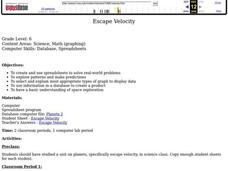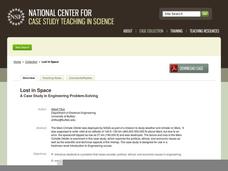McGraw Hill
Escape Velocity Interactive
How hard do you need to throw a ball in the air so that it never returns? Scientists call this measure the escape velocity. Classes can explore this concept through an intriguing interactive lesson. Pupils adjust velocities and observe...
Teach Engineering
The Great Gravity Escape
Groups simulate an orbit using a piece of string and a water balloon. Individuals spin in a circular path and calculate the balloon's velocity when the clothes pin can no longer hold onto the balloon.
NASA
Dark Matter NASA Conference
Young scholars calculate the escape velocity of planets in our solar system and use that knowledge to calculate the escape velocity for NGC 2300 group. They then suggest reasons for the escape velocity to be higher than possible given...
Curated OER
Escape Velocity
Sixth graders create/use spreadsheets to solve real-world problems, explore patterns, make predictions, select/explain most appropriate types of graph to display data, use information to create product, and have basic understanding of...
Curated OER
Lost in Space
Here is a case study for high school or college-level learners about space exploration equipment that has failed. The class reads about the Mars Climate Orbiter that was destroyed in 1999 and discusses the costs and benefits of space...
CK-12 Foundation
Satellites, Shuttles, and Space Stations: Satellites in Orbit
Blast off! How do satellites, space shuttles, and space stations escape Earth's gravity and achieve orbit? Young astronauts study rocket science (literally) with an interactive lesson. They discover the four main uses for satellites, how...
Curated OER
Weight and Velocity
Students perform an experiment in order to determine how increasing weight affects the velocity of a truck and use the computer to compile their data.
CK-12 Foundation
Dungeon Simulation
Tommy is stuck in a dungeon and can only escape if you can discover the correct formula for velocity! Through trial and error, scholars enter the velocity required for Tommy to reach the elevator at the proper time. Then they extrapolate...
Curated OER
Aerospace Engineering
Twelfth graders examine the physics of rocket flight. They build and launch model rockets to measure their performances.
EngageNY
Curves from Geometry
Escape to investigate hyperbolas. Pupils take a look at what happens to the elliptical orbital path of a satellite that exceeds escape velocity as the opener to the eighth lesson in a unit of 23. Scholars analyze basic hyperbolas and how...
Curated OER
Hovercraft
Students assess human impact on water quality. They determine how the force of friction retards motion. Pupils describe and measure quantities that characterize moving objects and their interactions within a system: Time, Distance,...
Curated OER
Volcanoes are a Blast-Working with Simple Equations
In this projectile motion worksheet, high schoolers solve 3 problems and an inquiry problem using three equations that describe projectile motion. One equation is for the maximum velocity to reach a height, H, the other is the maximum...
Physics Classroom
Free Fall
Scholars must understand freefall before they learn how objects like airplanes fly. They apply knowledge of velocity and acceleration to predict speed and direction as part of a larger series on vectors and projectiles.
Physics Classroom
Position-Time Graphs - Conceptual Analysis
Increasingly, colleges and employers want applicants with strong conceptual analysis skills, so give them some practice! Applying these skills to position-time graphs encourages synthesis of knowledge. To complete an installment of a...
Physics Classroom
Law Enforcement - Explosions
How do law enforcement officers determine the strength of an explosion based on the movement of objects around the point of origin? Scholars inspect the relative mass and velocities of two cars before and after an explosion. They perform...
Physics Classroom
Trajectory - Horizontally Launched Projectiles
Everyone enjoys projectiles, and predicting where they land helps with future hands-on labs. Incorporating gravity into horizontal trajectories through both conceptual and mathematical practice helps scholars understand real-life...
Physics Classroom
Trajectory - Angle Launched Projectiles
Horizontal and vertical speeds change as projectiles move through space. As part of a series on vectors and projectiles, scholars create vector diagrams to compare these speeds at various locations. They they determine the values for...
Physics Classroom
Match That Graph
Matchy-matchy no longer exclusively applies to fashion. Scholars work through three levels of practice matching position and velocity graphs. Part of a series covering dimensional kinematics, each question provides immediate feedback and...
Physics Classroom
Position-Time Graphs
Three sections review the key skills covered in a series on dimensional kinematics. The first covers the difference between distance and displacement. The second addresses the relationship between velocity and slope. The third includes...
Physics Classroom
Dots and Graphs
Scholars demonstrate understanding of kinematic graphs through matching dot graphs to position time graphs, dot graphs to velocity graphs, and a mixture of the two. If users feel stuck or confused, a Help Me! button offers an explanation...
Physics Classroom
Motion Diagrams
Scholars work through three activities building motion diagrams as part of a series exploring dimensional kinematics. Each activity has six descriptions requiring application of velocity vectors, acceleration vectors, and challenge...
Physics Classroom
Up And Down
Many scholars confuse velocity and acceleration even after they correctly solve basic problems. Using an interactive, part of a series on vectors and projectiles, with immediate feedback focuses their attention on the up or down...
Physics Classroom
Acceleration
The acceleration rate of a flea jumping works out to 50 times faster than the acceleration rate of the space shuttle. Pupils apply knowledge of acceleration to dot diagrams, velocity-time tables, and word problems. They solve for...

























